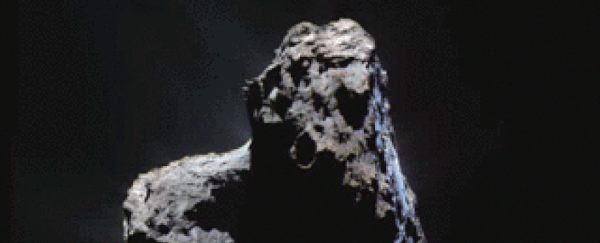In August 2014, the European Space Agency made history by successfully putting their Rosetta spacecraft in orbit around Comet 67P during its most recent trip through the Solar System.
Rosetta ended its mission by crash-landing into the comet last year, but images captured during its two years in orbit have now revealed that the comet's surface changed more dramatically and rapidly than expected as it approached the Sun.
As Comet 67P made its closest approach to the Sun, Rosetta saw three strange events occur on the surface: slopes retreating as fast as 5.4 metres (17.7 feet) per day; a boulder the size of a truck rolling more than the length of a football pitch; and the collapse of a 100-metre (328-foot) cliff - the first images of an avalanche ever captured on a comet.
Researchers have always suspected that the surface of a comet would be volatile as it approached the Sun, but this is the first time they've been able to collect substantial evidence of that happening - and they weren't expecting anything quite so dramatic.
"As comets approach the Sun, they go into overdrive and exhibit spectacular changes on their surface," said lead researcher Ramy El-Maarry, a member of the US Rosetta team over at the University of Colorado Boulder.
"This is something we were not able to really appreciate before the Rosetta mission, which gave us the chance to look at a comet in ultra-high resolution for more than two years."
Like most comets, Comet 67P has an elliptical orbit, which means it spends the majority of its time in the frozen depths of the outer Solar System.
Every 6.45 years or so, the comet travels through the inner Solar System, allowing the Sun's rays begin to warm the ice on and near the comet's surface - usually turning it straight into steam that can cause huge, unpredictable outbursts.
Based on Rosetta's images, the team now thinks the heating process is more complex than they previously imagined.
One of the most dramatic things they saw was the collapse of a huge cliff, triggering a landslide that exposed some of the interior body of Comet 67P.
You can see this happening between December 2014 and March 2016 below:
 ESA/Rosetta/MPS
ESA/Rosetta/MPS
The team thinks this collapse was caused by a large outflow of gas triggered by the Sun's rays heating up the comet's water content - and the images provide them with the first substantial evidence that these blasts of gas can cause avalanches on a comet.
But something else appears to have caused some of the other changes that Rosetta spotted - such as a huge crack forming in the neck of the comet, which could eventually decapitate it.
At the start of Rosetta's observations, the crack was around 487 metres (1,600 feet) in length - just slightly longer than the Empire State Building is tall. But in December 2014, it had increased in width by 30.5 metres (100 feet).
And images taken in June 2016 showed a new 150- to 304-metre (500- to 1,000-foot) crack forming in parallel to the original.
"The large crack was in the neck of the comet, a small central part that connects the two lobes," said El-Maarry. "The crack was extending, indicating that the comet may split up one day."
Instead of gas outbursts, the team thinks these cracks were formed as a result of the comet spinning quicker and quicker as it approached the Sun - another strange phenomenon documented by Rosetta.
One of the most dramatic changes on the comet was the shifting of a huge boulder in the Khonsu region on the larger of the two comet lobes.
Rosetta's images showed a boulder roughly the size of a truck and weighing 12,800 tonnes (28.2 million pounds) moving a ridiculous 140 metres (459 feet) - more than 1.5 times the distance of a football pitch.
 ESA/Rosetta/MPS
ESA/Rosetta/MPS
"The movement could have been triggered in one of two ways: either the material on which it was sitting eroded away, allowing it to roll downslope, or a forceful outburst could have directly lifted it to the new location," explains an ESA press release.
We still have a lot to learn about how comets change as they approach the Sun - information that will be crucial if we ever want to be able to safely land on, and potentially even mine, comets in the future.
But thanks to Rosetta, we now have a better idea of just how volatile the landscape can be, and what causes some of the most dramatic changes.
The research has been published in Science, and was presented this week at the 2017 Lunar and Planetary Sciences Conference in Texas.
